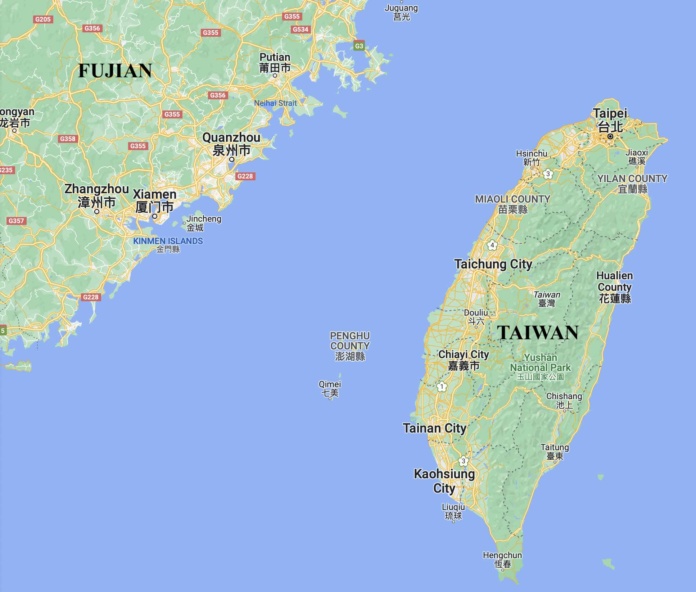Judging from the remarks made by the newly sworn-in Taiwan leader William Lai Ching-te on May 20, he touched on the political red lines of the People’s Republic of China (PRC), thereby leading to not only the severe criticisms from mainland authorities but also a two-day military exercise conducted by the People’s Liberation Army (PLA). The ongoing cross-strait tensions remain to be observed carefully, partly because the PLA military exercise sent important warning signals and partly because Taiwan’s legislative politics are pointing in the direction of more political turbulence – signs that will question whether the mainland’s anti-secession law would eventually be invoked in cross-strait relations and politics.

The inaugural speech made by William Lai, who was sworn in as the 16th “president” of Taiwan carried several characteristics that dangerously touched on the political red lines of the mainland.
His speech first emphasised Taiwan’s third rotation of political parties in power in 2024, with the first rotation taking place in 1996, when Taiwan had the first directly elected president. Yet Lai boasted that the Democratic Progressive Party (DPP) broke the so-called “illusionary spell” of changing the party in power after eight years of its governance. What he meant was that the DPP succeeded in continuing to govern Taiwan even after eight years of Tsai Ing-wen’s DPP leadership. In a sense, Lai was provocative to the mainland, which has been seeing the DPP regime as not only ignoring the 1992 consensus but also being far more pro-US than the Kuomintang and ignoring the Taiwan model of “one country, two systems.”
Lai then stressed Taiwan as not just “democratic” but also “a bright spot in the world of democracies,” adding that the island is the first Asian “state” allowing for same-sex marriage and that it succeeded in using “democracy” against the onslaught of COVID-19 and its variants.
His boast of Western-style democracy, as opposed to “Chinese democracy” that has been emphasised in the mainland, and his exaggeration of how Taiwan succeeded in repelling the attacks from COVID-19 became another provocative thorn to the mainland.
Lai turned to Taiwan’s strategic positioning in the “first chain of islands,” explicitly saying that Taiwan belongs to a strategic area under the US military protective umbrella—again, a huge provocation to the mainland authorities. Even worse, Lai stressed that the international “consensus” is that peace and stability in the Taiwan Strait is an “indispensable factor” in global security—a remark putting Taiwan under the rubric of “internationalisation” as opposed to the mainland’s emphasis that the Taiwan issue should not be “internationalised.”
Lai swiftly turned to the US legislation on the provision of military support for Taiwan—again, a clear provocation to the mainland side. He appealed to the PRC for “stopping literary attacks and military intimidation” and “shouldering the global responsibility together with Taiwan” – a double-edged sword that criticised the mainland on the one hand and elevated Taiwan’s status on par with the mainland globally on the other. This move of touching on, and perhaps exceeding, the mainland’s political red lines means that it is not surprising to witness the two-day military exercise of the PLA shortly after Lai delivered his speech.
The rest of Lai’s speech was about how the mainland side should “respect the choice of the Taiwan people,” how the mainland should “replace dialogue with confrontation” (while the mainland has been saying Taiwan should abandon confrontation by accepting the 1992 consensus), and how the mainland and Taiwan can and will become co-prosperous through allowing mainland students to study in Taiwan and through the allowance of “bilateral tourism.” Yet, the PRC has long maintained that the acceptance of the 1992 consensus as a precondition for the relaxation of mutual human exchange and interactions.
Even worse, Lai talked about Taiwan’s attempt at entering the CPTPP and its “united” efforts of protecting “sovereignty” with “non-subservient” relations between the island and the mainland – again a clear provocation to the mainland’s political bottom line.
Some observers have pointed to the fact that William Lam used the term Taiwan 79 times, the Republic of China (ROC) 9 times, and the ROC on Taiwan 3 times, while utilising the name, China, to refer to the mainland 7 times.
The mainland’s State Council Taiwan Affairs Office immediately criticised Lai as “a worker of Taiwan independence,” while Foreign Minister Wang Yi reiterated that the one-China principle remains the key one stabilizing the future directions of cross-strait relations.
The US Secretary of State Anthony Blinken congratulated William Lai for becoming the Taiwan leader, and he even appealed to the Congress to extend its “invitation” to Lai and deputy Hsiao Bi-khim to visit Washington – a remark provoking the Chinese Foreign Ministry to issue a rebuttal at once, saying that the US side “seriously violating the one-China principle” and the three Sino-US communiques on Taiwan. The Chinese Foreign Ministry added that the Blinken remarks “sent seriously wrong signals” to the Taiwan separatists.
The verbal exchanges between the US side and China clearly demonstrated that Washington has backed up Taiwan’s efforts at “internationalisation” and that the mainland Chinese authorities have regarded such joint US-Taiwan moves as politically unacceptable from the perspective of megaphone diplomacy.
Three days after Lai delivered his speech, the PLA conducted a military exercise, namely Joint Sword-2024A, surrounding the island of Taiwan, mobilising the navy, the air force, and the rocket force. The Eastern Theatre Command led the military exercise in the Taiwan Strait, including Taiwan’s northern, southern, and eastern parts, the Mazu island, Wuqiu, and Dongyin.
For the first time in the mainland’s military exercises, Taiwan’s outlying islands were included. The locations this time were different from the locations of the PLA’s live-fire drills in August 2022, following Nancy Pelosi’s visit to Taiwan. Altogether, these locations of the mainland military exercises constitute a broad geo-military chain encircling Taiwan, meaning that the mainland military has the capability to impose an economic blockade easily on Taiwan and that it will have the ability to “take back” Taiwan strategically. As Zhang Chi, a professor at the National Defence University in Beijing, said that the PLA could “occupy main passages” and that “there is no longer a so-called blind spot” for PLA strikes from the eastern part of Taiwan. The implication is that Taiwan’s eastern logistical supply routes can be easily blocked by the mainland military.
In response to the mainland military exercise, the Taiwan presidential office expressed its regret, and the US Indo-Pacific Command deputy commander Stephen Sklenka regarded such exercise as “expected.” He appealed to the neighbours of Taiwan to “condemn” the mainland exercise.
Some mainland military strategists observed that the PLA military exercise had three characteristics: (1) the mainland marine police vessels went into the Taiwan waters while the mainland warships and fighter airplanes went near Taiwan to “squeeze” the Taiwan military defence space; (2) the PLA could encircle Taiwan’s outlying islands in the west and demonstrate its striking capability in the eastern part of Taiwan; and (3) the PLA could damage the northern Taiwanese military targets, blockade the naval outlet of Kaohsiung, and cut the external (air and water) supply lines of Taiwan’s Hualien.
The Eastern Theatre Command released a map and posters of six PLA weapons that were deployed in the military exercise, namely J-20 and J-16 fighter aircraft, Type 052D destroyer, Type 071 amphibious transport dock, a Dongfeng series ballistic missile, and PHL-16 Multiple Rocket Launch System (MRLS). A video was released, showing that frigate CNS Nantong was participating in the military drills.
Interestingly, the Eastern Theatre Command issued 3D virtual animations, showing that the PLA missiles could hit three places in Taiwan, namely Taipei, Kaohsiung, and Hualien – a gesture pointing to the ability of the mainland missiles to strike at these Taiwan targets.
In Hualien, ten F16 fighter aircrafts were on high alert with their weapons ready to deal with any possible emergency. At the same time, the US aircraft carrier USS Ronald Regan (CVN-76) was operating in the Philippine Sea when China launched the two-day military exercise encircling Taiwan. The US Navy also conducted bilateral military operations with the Royal Netherlands Navy in the South China Sea – a gesture perhaps coincidentally in response to the Chinese military exercise. The US and Dutch operations involved combat ship USS Mobile (LCS-26), dry cargo ship USNS Wally Schirra (T-AKE-8) and Royal Netherlands Navy frigate HNLMS Tromp (F803).
Amid cross-strait tensions, Taiwan’s legislative politics have gone increasingly contentious. The Kuomintang and the People Party attempted to amend a legislation to allow legislators to summon private individuals and government officials to face legislators’ questions and to penalise them for any “contempt of the legislature” for up to three years in prison. The DPP and critics have argued that the move “violates” the constitutional arrangements, making the legislature a place of “authoritarianism.” Thousands of demonstrators gathered outside the Legislative Assembly on May 21, a situation recalling the so-called Sunflower Movement in 2014, when a free trade agreement between the KMT and the mainland triggered a month-long occupation of the legislature by political opponents and DPP supporters.
The implication here is that Taiwan’s domestic political turbulence is now exacerbated by partisan politics and struggles within the Legislative Assembly – a situation that can be seen as potentially dangerous in cross-strait relations. According to the mainland’s anti-secession law, which was ratified in March 2005, two important provisions could provide the justifications for the PRC intervention in Taiwan’s political turbulence and chaos. Article 8 says that the mainland Chinese state shall use non-peaceful and other necessary means to deal with Taiwan under the condition of Taiwan’s separatist forces “accomplishing the fact” of such “separation,” or of a main event occurring in Taiwan that leads to its “separation” from mainland China, or of a scenario in which all the possibilities of peaceful reunification are lost. Article 9 says that the mainland Chinese state must act to protect the persons and properties of Taiwan’s civilians and foreigners for the sake of minimising their losses. The ambiguous wordings in Articles 8 and 9 can arguably provide for the PLA military intervention in Taiwan if the island has worsening internal political struggles, disturbances, and turbulences.
In conclusion, the ongoing cross-strait tensions illustrate that the highly political, rhetorical and provocative speech made by William Lai not only alienated the mainland authorities but also triggered the PLA military exercise, which unprecedentedly mobilized the marine police to go into the waters near the Taiwan outlying islands, and which demonstrated the PLA capabilities of blockading Taiwan, striking the essential targets and cutting off Taiwan’s external supply lines. Perhaps the megaphone diplomacy conducted simultaneously by the US side triggered the corresponding response from the mainland Chinese side. However, Taiwan’s ongoing internal political struggles inside and outside the Legislative Assembly are showing some signs of deterioration in the coming years, leading to a possible scenario that the 2005 Anti-Secession Law may eventually be applied by the mainland. If so, political rhetoric, megaphone diplomacy, military muscle-flexing actions, and domestic political struggles have become a new chain of political development that heightened the highly unpredictable, oscillating, and unstable cross-strait relations.
*Sonny Shiu-Hing Lo is a political scientist, veteran commentator, and author of dozens of books and academic articles on Hong Kong, Macau, and Greater China




















